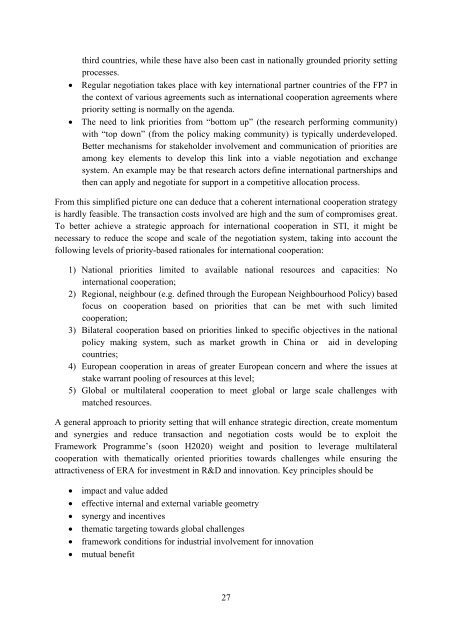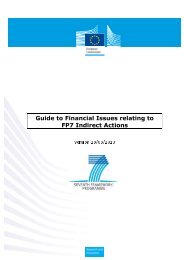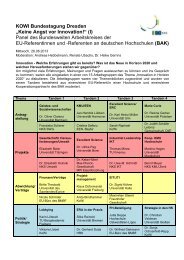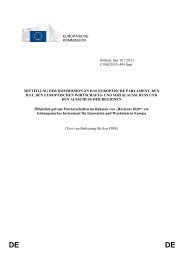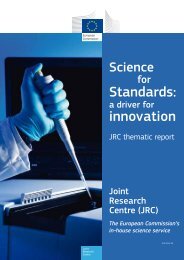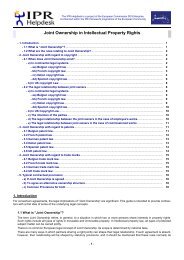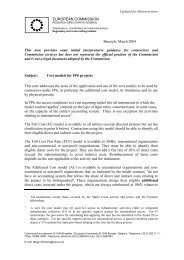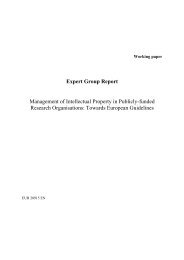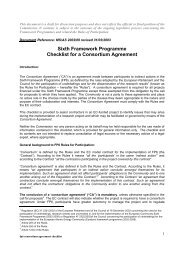Draft Report of the Expert Group on International STI Cooperation to ...
Draft Report of the Expert Group on International STI Cooperation to ...
Draft Report of the Expert Group on International STI Cooperation to ...
You also want an ePaper? Increase the reach of your titles
YUMPU automatically turns print PDFs into web optimized ePapers that Google loves.
third countries, while <str<strong>on</strong>g>the</str<strong>on</strong>g>se have also been cast in nati<strong>on</strong>ally grounded priority setting<br />
processes.<br />
• Regular negotiati<strong>on</strong> takes place with key internati<strong>on</strong>al partner countries <str<strong>on</strong>g>of</str<strong>on</strong>g> <str<strong>on</strong>g>the</str<strong>on</strong>g> FP7 in<br />
<str<strong>on</strong>g>the</str<strong>on</strong>g> c<strong>on</strong>text <str<strong>on</strong>g>of</str<strong>on</strong>g> various agreements such as internati<strong>on</strong>al cooperati<strong>on</strong> agreements where<br />
priority setting is normally <strong>on</strong> <str<strong>on</strong>g>the</str<strong>on</strong>g> agenda.<br />
• The need <strong>to</strong> link priorities from “bot<strong>to</strong>m up” (<str<strong>on</strong>g>the</str<strong>on</strong>g> research performing community)<br />
with “<strong>to</strong>p down” (from <str<strong>on</strong>g>the</str<strong>on</strong>g> policy making community) is typically underdeveloped.<br />
Better mechanisms for stakeholder involvement and communicati<strong>on</strong> <str<strong>on</strong>g>of</str<strong>on</strong>g> priorities are<br />
am<strong>on</strong>g key elements <strong>to</strong> develop this link in<strong>to</strong> a viable negotiati<strong>on</strong> and exchange<br />
system. An example may be that research ac<strong>to</strong>rs define internati<strong>on</strong>al partnerships and<br />
<str<strong>on</strong>g>the</str<strong>on</strong>g>n can apply and negotiate for support in a competitive allocati<strong>on</strong> process.<br />
From this simplified picture <strong>on</strong>e can deduce that a coherent internati<strong>on</strong>al cooperati<strong>on</strong> strategy<br />
is hardly feasible. The transacti<strong>on</strong> costs involved are high and <str<strong>on</strong>g>the</str<strong>on</strong>g> sum <str<strong>on</strong>g>of</str<strong>on</strong>g> compromises great.<br />
To better achieve a strategic approach for internati<strong>on</strong>al cooperati<strong>on</strong> in <strong>STI</strong>, it might be<br />
necessary <strong>to</strong> reduce <str<strong>on</strong>g>the</str<strong>on</strong>g> scope and scale <str<strong>on</strong>g>of</str<strong>on</strong>g> <str<strong>on</strong>g>the</str<strong>on</strong>g> negotiati<strong>on</strong> system, taking in<strong>to</strong> account <str<strong>on</strong>g>the</str<strong>on</strong>g><br />
following levels <str<strong>on</strong>g>of</str<strong>on</strong>g> priority-based rati<strong>on</strong>ales for internati<strong>on</strong>al cooperati<strong>on</strong>:<br />
1) Nati<strong>on</strong>al priorities limited <strong>to</strong> available nati<strong>on</strong>al resources and capacities: No<br />
internati<strong>on</strong>al cooperati<strong>on</strong>;<br />
2) Regi<strong>on</strong>al, neighbour (e.g. defined through <str<strong>on</strong>g>the</str<strong>on</strong>g> European Neighbourhood Policy) based<br />
focus <strong>on</strong> cooperati<strong>on</strong> based <strong>on</strong> priorities that can be met with such limited<br />
cooperati<strong>on</strong>;<br />
3) Bilateral cooperati<strong>on</strong> based <strong>on</strong> priorities linked <strong>to</strong> specific objectives in <str<strong>on</strong>g>the</str<strong>on</strong>g> nati<strong>on</strong>al<br />
policy making system, such as market growth in China or aid in developing<br />
countries;<br />
4) European cooperati<strong>on</strong> in areas <str<strong>on</strong>g>of</str<strong>on</strong>g> greater European c<strong>on</strong>cern and where <str<strong>on</strong>g>the</str<strong>on</strong>g> issues at<br />
stake warrant pooling <str<strong>on</strong>g>of</str<strong>on</strong>g> resources at this level;<br />
5) Global or multilateral cooperati<strong>on</strong> <strong>to</strong> meet global or large scale challenges with<br />
matched resources.<br />
A general approach <strong>to</strong> priority setting that will enhance strategic directi<strong>on</strong>, create momentum<br />
and synergies and reduce transacti<strong>on</strong> and negotiati<strong>on</strong> costs would be <strong>to</strong> exploit <str<strong>on</strong>g>the</str<strong>on</strong>g><br />
Framework Programme’s (so<strong>on</strong> H2020) weight and positi<strong>on</strong> <strong>to</strong> leverage multilateral<br />
cooperati<strong>on</strong> with <str<strong>on</strong>g>the</str<strong>on</strong>g>matically oriented priorities <strong>to</strong>wards challenges while ensuring <str<strong>on</strong>g>the</str<strong>on</strong>g><br />
attractiveness <str<strong>on</strong>g>of</str<strong>on</strong>g> ERA for investment in R&D and innovati<strong>on</strong>. Key principles should be<br />
• impact and value added<br />
• effective internal and external variable geometry<br />
• synergy and incentives<br />
• <str<strong>on</strong>g>the</str<strong>on</strong>g>matic targeting <strong>to</strong>wards global challenges<br />
• framework c<strong>on</strong>diti<strong>on</strong>s for industrial involvement for innovati<strong>on</strong><br />
• mutual benefit<br />
27


